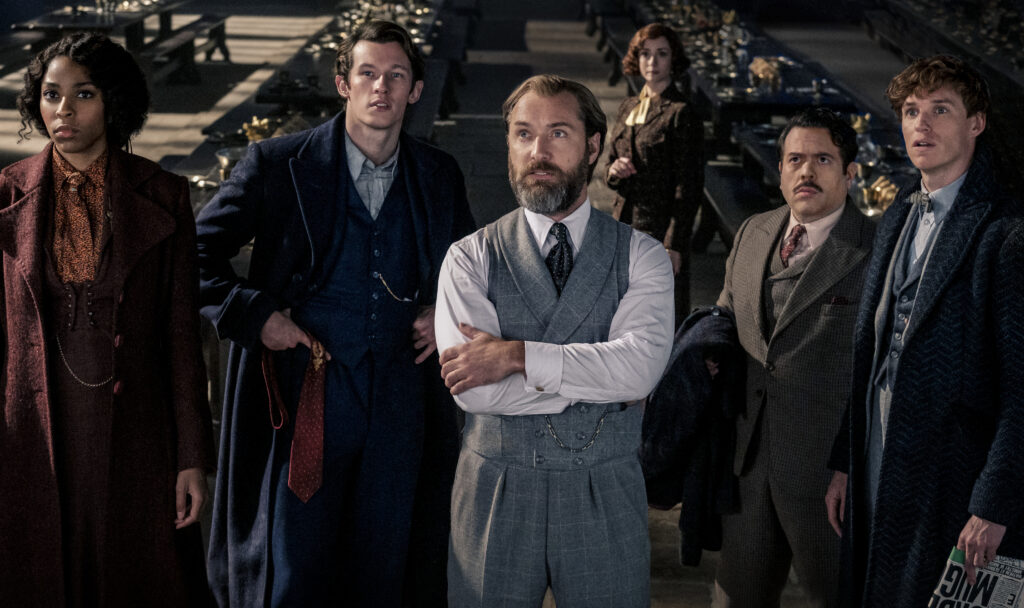April 5, 2022
by Carla Hay

“Fantastic Beasts: The Secrets of Dumbledore”
Directed by David Yates
Culture Representation: Taking place in the 1930s in the United Kingdom, New York City, China, Germany, Austria and Bhutan, the fantasy film “Fantastic Beasts: The Secrets of Dumbledore” features a predominantly white cast of characters (with some black people and Asians) portraying wizards, witches and Muggles (humans with no magical powers).
Culture Clash: In this prequel movie to the “Harry Potter” series, good wizard Albus Dumbledore assembles a team to do battle against his former lover Gellert Grindelwald, an evil wizard who wants to oppress Muggles and take over the world.
Culture Audience: Besides appealing to the obvious target audience of “Harry Potter” universe fans, “Fantastic Beasts: The Secrets of Dumbledore” will appeal to viewers of fantasy films about battling wizards, but viewers of this jumbled movie will be very confused unless they saw or know what happened in 2018’s “Fantastic Beasts: The Crimes of Grindelwald.”

Messy and often tedious, “Fantastic Beasts: The Secrets of Dumbledore” stumbles and fumbles around like a franchise in search of a coherent plot. It’s ironic that this sequel about battling wizards has lost the magic of the first “Fantastic Beasts” movie and doesn’t even come close to the best “Harry Potter” movies. The “Fantastic Beast” movies, which are the prequels to the “Harry Potter” movies, began with 2016’s “Fantastic Beasts and Where to Find Them” and continued with 2018’s “Fantastic Beasts: The Crimes of Grindelwald” and 2022’s “Fantastic Beasts: The Secrets of Dumbledore.”
David Yates, who directed the last four “Harry Potter” movies, directed all three of these “Fantastic Beasts” movies, and he has been announced as the director of more “Fantastic Beasts” movies. Unfortunately, “Fantastic Beasts: The Secrets of Dumbledore” looks like a movie where, even though many of the same filmmakers from previous “Fantastic Beasts” movies are involved, they’ve gotten too self-satisfied with their financial success and are just churning out uninspired mediocrity. “Fantastic Beasts: The Secrets of Dumbledore” is a perfect example of a movie with “sequel-itis,” where there’s little to no effort to surpass the creativity of the first (and usually best) movie in the series.
“Harry Potter” and “Fantastic Beasts” book series author J.K. Rowling has been the screenplay writer for the “Fantastic Beasts” movies. For “Fantastic Beasts: The Secrets of Dumbledore,” Rowling and Steve Kloves are the credited screenwriters. However, they make the mistake that a lot of movie sequel screenwriters make when crafting a story: assuming that everyone seeing the movie saw a preceding movie in the series.
If you don’t know who Grindelwald and Dumbledore are, if you wouldn’t be able to tell the difference between a magician and a Muggle, and you don’t care enough to find out, then “Fantastic Beasts: The Secrets of Dumbledore” is not the movie for you. But if you are new to the franchise and are curious, then you probably still need to go and watch the previous “Fantastic Beasts” movies to fully understand what’s going on in “Fantastic Beasts: The Secrets of Dumbledore.” Otherwise, too many parts of the film will be baffling to you.
What is easy to understand is that “Fantastic Beasts: The Secrets of Dumbledore” has the predictable cliché of a good leader versus a bad leader, who wants to take over the world/universe/fill-in-the-blank space with whatever population. If it’s a fantasy film, various supernatural powers are used and/or spells are cast. And then, it all leads to a big showdown that has the expected outcome. The End.
“Fantastic Beasts: The Secrets of Dumbledore” follows the same formula, but it doesn’t care enough to inform new viewers about meaningful backstories of the main characters. Viewers would have to know in advance that magizoologist Newton “Newt” Scamander (played by Eddie Redmayne) is a British Ministry of Magic employee, who works in the Beasts Division of the Department for the Regulation and Control of Magical Creatures. Viewers would also have to know that Newt is the protégé of Albus Dumbledore (played by Jude Law), a highly respected member of the British Wizarding Community and a professor at Hogwarts School of Witchcraft and Wizardry, where he teaches students how to defend against the dark arts. (It’s the school that’s later attended by Harry Potter and his friends.)
Viewers would also have to know that Dumbledore is gay and that he and his ex-lover Gellert Grindelwald (played by Mads Mikkelsen, replacing Johnny Depp in the role), who were a couple when they were in their late teens, are now sworn enemies, because Grindelwald is now an evil wizard who wants to take over the world. One thing that “Fantastic Beasts: The Secrets of Dumbledore” does explain more than adequately (and repeats to the point where it insults viewers’ intelligence) is that Dumbledore and Grindelwald made a blood pact when they were a couple to never directly harm each other. This pact manifests itself in the movies with thorn-like chains around their wrists and a pendant that gets pulled out to show from time to time.
Viewers would also have to know that in this world populated by secret and not-so-secret wizards and witches, human beings with no magical powers are called Muggles. One of these Muggles is Jacob Kowalski (played by Dan Fogler), a lovelorn baker who has been Newt’s ally in all of the “Fantastic Beasts’ movies. However, Jacob has mixed feelings about helping Newt in “Fantastic Beasts: The Secrets of Dumbledore.” That’s because he’s in love with a witch named Queenie Goldstein (played by Alison Sudol), who was in a forbidden romance with Jacob because it’s taboo for wizards and witches to have romantic relationships with and marry human beings.
Viewers would also have to know the backstory about Newt’s sometimes tension-filled relationship with his older brother Theseus Scamander (played by Callum Turner), who is considered an upstanding employee of the British Ministry of Magic. By contrast, Newt is considered an unpredictable, somewhat roguish employee of the British Ministry of Magic. As explained in “Fantastic Beasts: The Crimes of Grindelwald,” Newt and Theseus fell in love with the same woman named Leta Lestrange (played by Zoë Kravitz), whose fate is shown in that movie.
And then there’s the complicated history of Credence Barebone (played by Ezra Miller), whose real name was revealed to be Aurelius Dumbledore in “Fantastic Beasts: The Crimes of Grindelwald.” He’s been caught in a tug-of-war between good and evil. In the beginning of “Fantastic Beasts: The Secrets of Dumbledore,” Credence/Aurelius (who is very dour and mopey) is on evil Grindelwald’s side. And so is Queenie, the love of Jacob’s life.
What does all of this mean? Dumbledore is going to assemble a team to defeat Grindelwald, who is a political candidate in the upcoming election for supreme head of the International Confederation of Wizards (ICW). This election is supposed to show that Grindelwald is not going to operate in the underworld, but he wants to become part of the establishment government in power. Grindelwald’s two opponent candidates in this election are Brazil’s minister of magic Vicência Santos (played by Maria Fernanda Cândido) and China’s minister of magic Liu Tao (played by Dave Wong), while the outgoing ICW supreme head is Anton Vogel (played by Oliver Masucci), who is Germany’s minister of magic.
In addition to Newt and Jacob, the others who are on Dumbledore’s team are Professor Eulalie “Lally” Hicks (played by Jessica Williams), a sassy teacher at Ilvermorny School of Witchcraft and Wizardry; Yusuf Kama (played by William Nadylam), an even-tempered Senegalese French wizard; and Bunty Broadacre (played by Victoria Yeates), who is Newt’s loyal and trustworthy assistant. Queenie’s sister Porpentina “Tina” Goldstein (played by Katherine Waterston), a love interest of Newt’s, makes a brief appearance toward the end of the movie. Aberforth Dumbledore (played by Richard Coyle), Albus’ somewhat estranged brother and the owner of the Hog’s Head Inn, is in the movie as an explanation for more of the Dumbledore family history.
And you can’t have a movie called “Fantastic Beasts” without some magical creatures running around. In “Fantastic Beasts: The Secrets of Dumbledore,” the creature at that’s the center of the story’s intrigue is the rare Qilin (pronounced “chillin”), which looks like a combination of a horse and a dragon. The Qilin has the ability to read someone’s heart and determine if someone is good or evil. In the beginning of the movie, Newt discovers a Qilin that has given birth. However, Grindelwald wants to kill any Qilins, to prevent Grindelwald’s dark heart and sinister intentions from being exposed.
There’s also the Manticore, a three-eyed beast that’s up to no good and looks like a combination of a crab/lobster and a scorpion. And there’s a shape-shifting avian creature called a Wyvern. Returning to the “Fantastic Beasts” series are the Bowtruckle named Pickett and the Niffler named Teddy. Although these creatures all contribute some way to the story, the visual effects for these creatures and the battle scenes won’t be winning any awards.
The opening scene of “Fantastic Beasts: The Secrets of Dumbledore” is an example of how drab the movie is when in areas it should be electrifying and intriguing. The scene shows Albus Dumbledore and Grindelwald meeting each other at a restaurant. A scene that should sizzle with unresolved feelings between these two former lovers just ends up fizzling with dull dialogue.
Dumbledore tells Grindelwald of their blood oath to never directly harm each other: “We can free each other of it.” Dumbledore adds, “I was in love with you.” Grindelwald is unmoved and expresses his disgust of Dumbledore interacting with Muggles: “Do you really intend to turn your back on your own kind?” Grindelwald sneers. And of the human customers in the restaurant, Grindelwald asks Dumbledore if he can “smell the stench [of humans] in the room.”
“Fantastic Beasts: The Secrets of Dumbledore” has more monotonous conversations throughout the movie, which makes the characters’ personalities very hollow and formulaic. The story has a lot of globetrotting to several countries to distract from the weak plot. The pacing is too slow in areas where there should be a higher level of intrigue. Many of the action scenes are poorly staged and look too forced and awkward. There’s nothing wrong with any of the cast members’ performances in “Fantastic Beasts: The Secrets of Dumbledore,” but there’s no real spark to anything about this movie, which plods along until its very predictable conclusion.
The movie’s biggest failing is not adequately explaining crucial backstories. (At one point in the film, Lally does a rushed “exposition dump” by giving a babbling summary of what happened in the first two “Fantastic Beasts” movies.) The film’s lackluster dialogue and trite action scenes don’t help matters. The end result is a movie that seems to take its loyal fan base for granted and doesn’t really make new “Fantastic Beasts” viewers feel welcome.
Warner Bros. Pictures will release “Fantastic Beasts: The Secrets of Dumbledore” in U.S. cinemas on April 15, 2022. HBO Max will premiere the movie on May 30, 2022.


